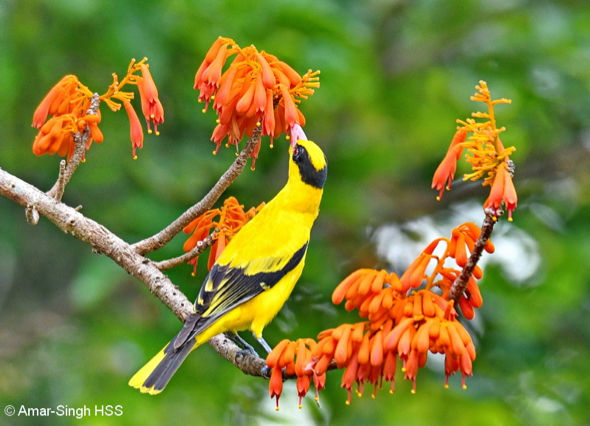“The Sterculia colorata (Scarlet Sterculia or Bonfire Tree) originates from the forests of the Western Ghats and the Deccan in India. A few trees have been planted in Ipoh in the 1960s. It flowers once a year and sheds all its leaves at the same time. Brilliant orange flowers, hanging downwards, are produced in dense panicles at the ends of branches. I observed a number of birds feeding on the nectar, including: Black-naped Orioles (Oriolus chinensis maculatus), Brown-throated Sunbirds (Anthreptes malacensis malacensis) and Yellow-vented Bulbuls (Pycnonotus goiavier analis). Also, the Plantain Squirrels (Callosciurus notatus).

“The flowers are 30 mm long. The Black-naped Orioles (above) and Yellow-vented Bulbuls take nectar the conventional way, through the front.

“The Brown-throated Sunbirds use both nectar robbing and conventional nectar feeding techniques (above, below).

“The Plantain Squirrels eat the flowers to acquire the nectar (below).

“I am sure many other bird species visit these flowers. A good article on bird-pollination of this tree is: Solomon Raju, Purnachandra Rao, Ezradanam. Bird-pollination in Sterculia colorata Roxb. (Sterculiaceae), a rare tree species in the Eastern Ghats of Visakhapatnam and East Godavari Districts of Andhra Pradesh. Current Science, Vol. 87, No. 1, 10 July 2004. The authors found that the flowers on average secrete 15 ul of nectar. They record a number of bird species visiting the flowers including: Bulbuls, Tits, Flowerpeckers, Sunbirds, White-eyes and Rosefinch. While the majority come for the nectar, the authors note that Bulbuls and Tits come for the larvae in flowers and buds; and the Rosefinch ate flower buds.
“I cannot be sure that the same does not apply to the Black-naped Orioles and Yellow-vented Bulbuls I observed, however they appeared to be taking the nectar. The Brown-throated Sunbirds I saw were definitely nectar feeding and some were heavily pollen-stained.”
Dato’ Dr Amar-Singh HSS
Ipoh, Perak, Malaysia
12th April 2019
Location: Ipoh, Perak, Malaysia
Habitat: Urban environment








